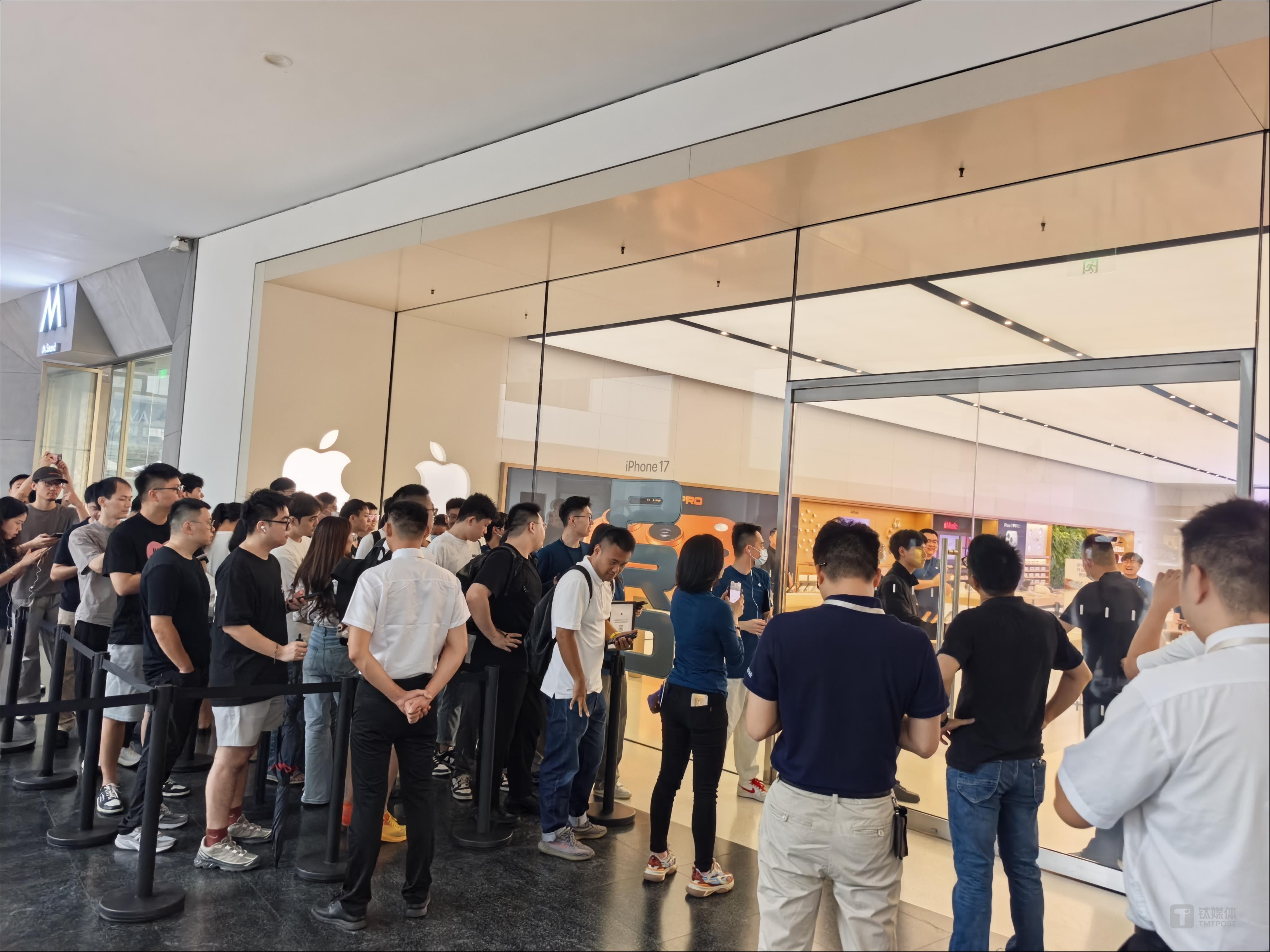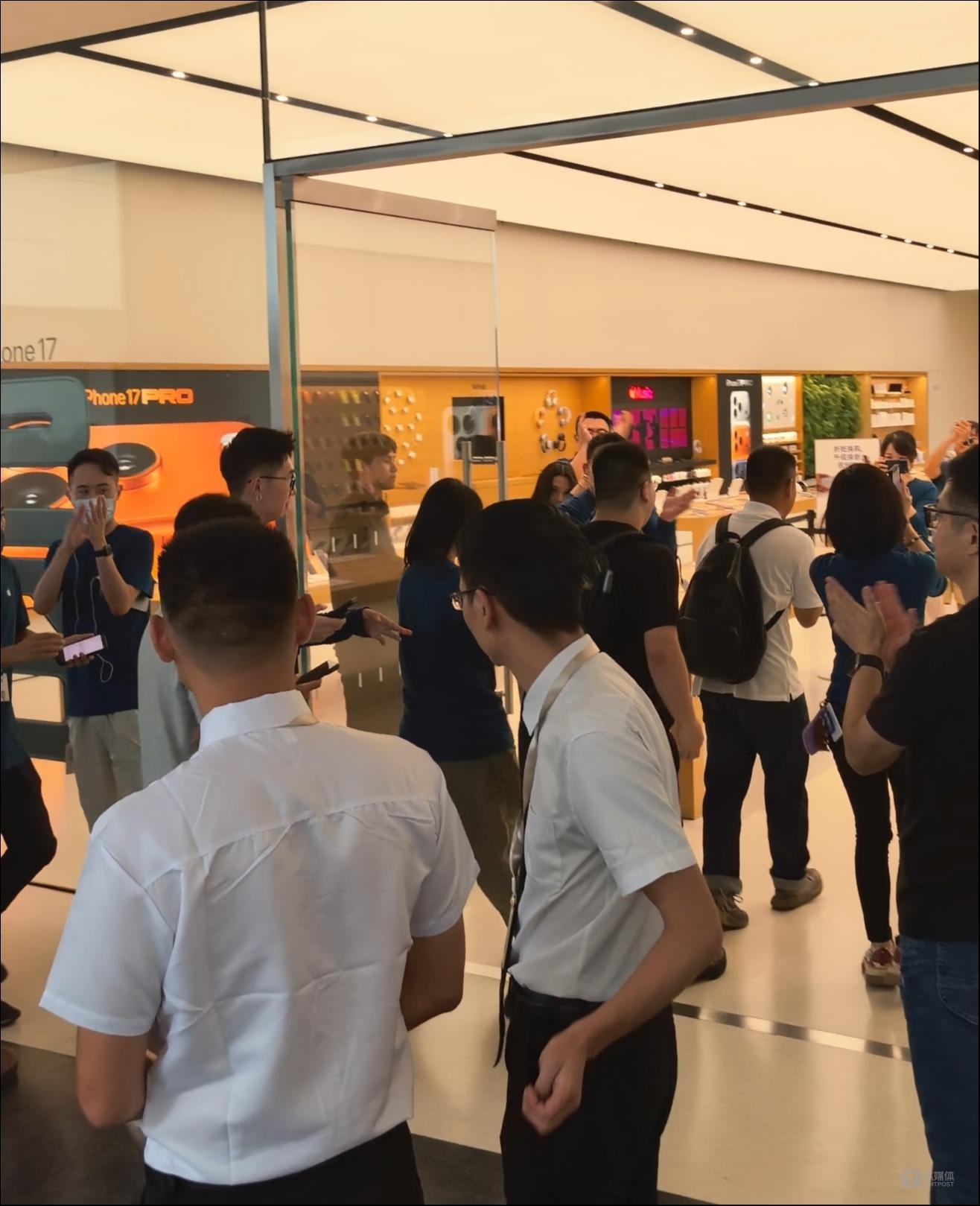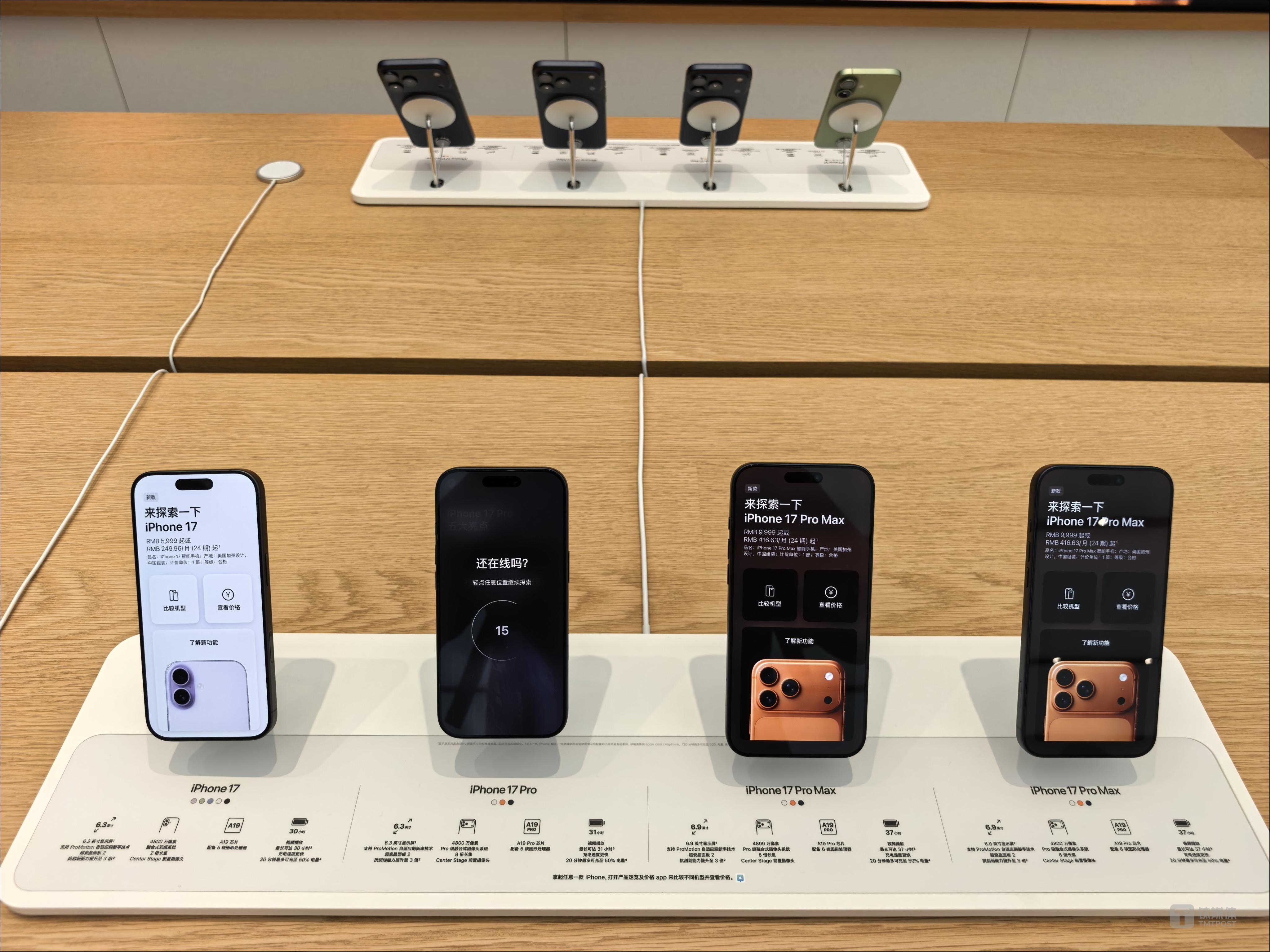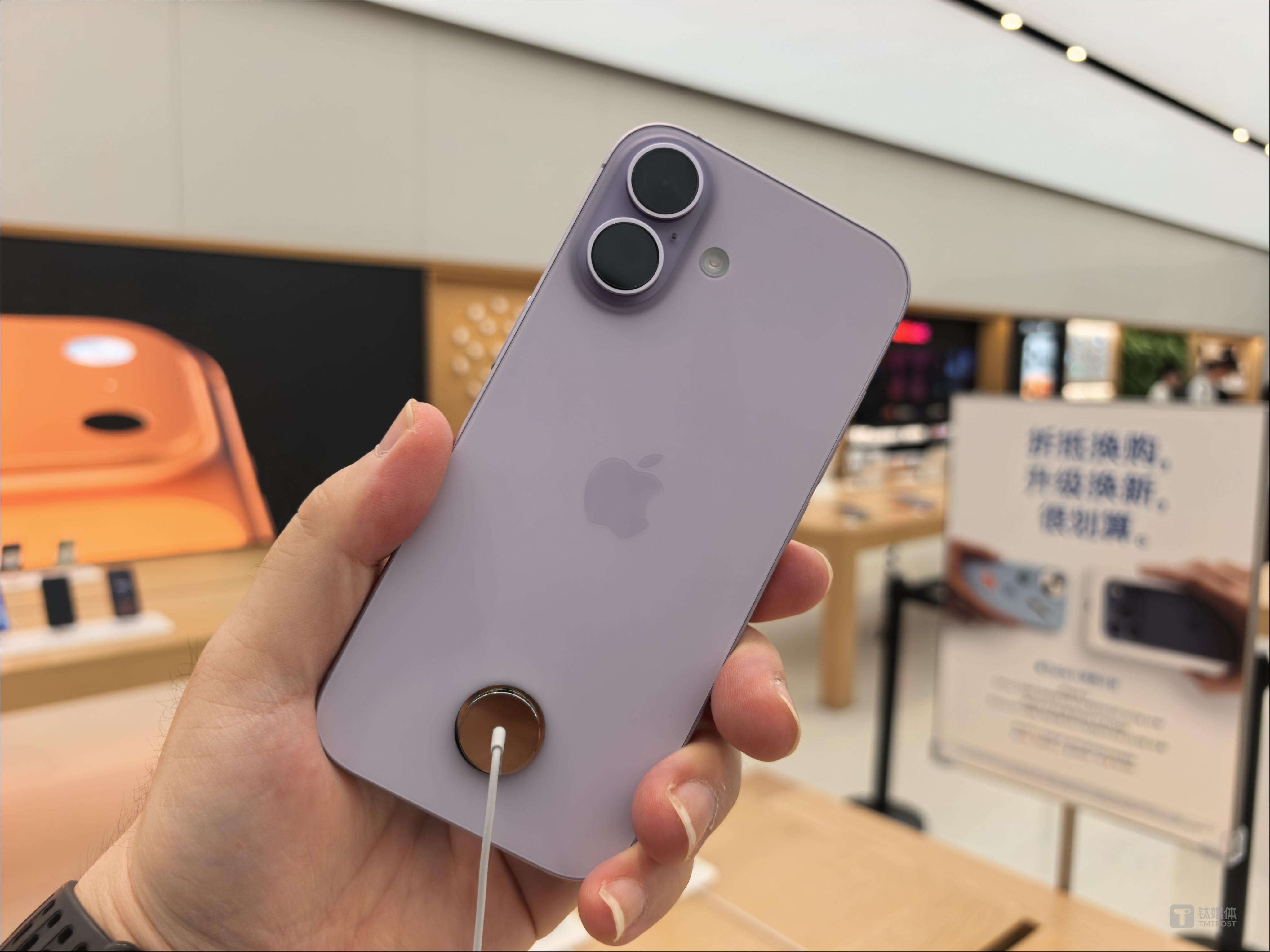TMTPOST — Apple’s iPhone 17 series officially went on sale Friday in China, drawing long lines of eager consumers and fueling a surge of activity in both the primary and secondary markets. From early morning queues in Beijing to bustling crowds outside Apple stores in Xiamen, the launch reflects robust demand for Apple’s latest flagship devices, despite domestic competition and ongoing market fluctuations.
“I arrived a little after five in the morning, but to my surprise, someone got here even earlier than I did,” said one Apple fan waiting to pick up their device. “The iPhone 17 Pro looks drastically different this year, and after watching some review videos, its camera capabilities seem even stronger. My iPhone 14 Pro can finally ‘retire.’”
By 8 a.m. Beijing time, the iPhone 17 series was officially available for sale. Although the iPhone Air was not offered in China at launch due to eSIM restrictions, fans showed no signs of slowing down. Outside the Apple Store in Xiamen, crowds gathered not only to collect pre-ordered devices but also to purchase the latest models on-site, highlighting the ceremonial aspect of Apple’s retail experience.


Photo taken by the author
Launch day would not be complete without the presence of scalpers. These resellers buy devices in bulk to sell at a premium, capitalizing on the initial rush of consumers. “Unlike the past year or two, this year’s iPhone has changed quite a bit. You can make a decent profit on day one—even the standard model can fetch an extra 100 yuan. But after 10 a.m., the prices will change again,” one scalper said.
A distributor told the author that the day before sales began, the iPhone 17 lineup had seen price increases, with the highest markup on the Pro Max 256GB version at 850 yuan. Standard and Pro models experienced markups ranging from 100 to 200 yuan. In contrast, last year’s iPhone 16 standard edition had fallen below retail price prior to launch, drawing little interest from scalpers.
The author also observed scalpers buying from customers picking up pre-orders and immediately reselling devices for an extra 200 yuan to those eager to obtain a phone without waiting in line. Some arrived earlier than the actual buyers to secure the first batch of units, highlighting the growing intensity of competition on launch day.

Xiamen Apple Store, photo taken by the author
Many fans were particularly focused on the iPhone 17 Pro, with some loyal customers upgrading annually. “I managed to get an iPhone 17 Pro in silver. It was much harder than in previous years—last year I snagged three, kept one for myself, and sold the other two to ‘subsidize’ my own purchase,” said one customer. The surge in demand meant that even experienced buyers had to arrive early to secure their devices.
Despite fast express delivery services from platforms like Meituan and Taobao Flash Sale, many customers prefer in-store pickup for the excitement of launch day—the countdowns, cheers, and communal experience cannot be replicated online.
Pre-orders for the iPhone 17 series opened at 8 p.m. on September 12. The new Pro model features a complete redesign, while the standard iPhone 17 boasts a high-refresh-rate display, supports up to 40W fast charging, and qualifies for national subsidies. As soon as pre-orders went live, all channels, including Apple’s website, JD.com, and Taobao, sold out immediately. Proxy purchasing services on platforms like Xianyu charged around 200 yuan per device.
Within the first half-hour of pre-sales on Apple’s official website, the silver iPhone 17 Pro series proved the most popular, selling out quickly across all storage options. Delivery dates for online orders were pushed back to mid-October, while limited in-store stock remained for high-capacity models. The Starlight Orange variants and larger storage options were also in high demand, whereas Deep Blue remained less popular.
Interestingly, the standard iPhone 17 edition became a hot commodity this year. With enhanced performance, fast charging, and subsidies, the standard model accounted for nearly half of total sales, according to TMTPost App data. Scalpers, who historically avoided the standard edition, now openly sought any iPhone 17 model.
Apple staff noted that inventory was dynamic and almost impossible to find in-store during the first few days post-launch. Customers were advised to refresh the website continuously and place orders promptly, regardless of pickup times or locations. Apple also reserves stock for participants in its annual upgrade program, offering an additional advantage to those with AppleCare+.

iPhone 17 series on sale, photo taken by the author
Scalpers benefited from the strong upgrades in design and performance, but premiums were unstable. According to Huaqiangbei vendors, the standard iPhone 17 carried a 100–200 yuan markup, while the Pro model added around 200 yuan. The Pro Max saw the highest premiums, ranging from 500 to 1,000 yuan, with color variations affecting the price.
Within half an hour of launch, the author noted that markups had already started to decline. “Yesterday, premiums were high because buyers were lined up. Now the highest on-site premium is about 700 yuan. In Beijing or Shanghai, it may be slightly higher, but here in Xiamen, 700 yuan is the max,” a scalper said.
Subsidies from platforms such as Pinduoduo further disrupted market expectations. Some buyers pre-negotiated fixed prices with scalpers, paying deposits in advance and securing their phones regardless of the market price upon delivery.

iPhone 17 series, photo taken by the author
The launch also boosted second-hand iPhone activity. Data from Zhuanzhuan showed that searches for Apple phones increased by 150%, transaction volumes rose 90%, and inquiries about recycling Apple devices jumped more than 200% compared to the previous period. The iPhone 16 series saw recycling inquiries rise over 350%, signaling strong market interest in upgrading to the latest models.

iPhone 17, photo taken by the author
With steady upgrades in performance and new design features, Apple has once again captured consumer attention. The iPhone 17 series has rekindled enthusiasm for the brand, providing both social cachet and technological innovation that domestic competitors have yet to fully match.
After a period of declining market share in China, partly due to the rise of domestic brands, the iPhone 17 series may represent a turning point. Analysts predict that the standard iPhone 17, with its combination of affordability, performance, and subsidies, could pose a serious challenge to domestic flagship models.
Apple plans to introduce design updates annually, and the iPhone 17 sets a precedent for the company’s approach to the next-generation iPhone 18 series. Reports indicate that Apple has informed supply chain partners to target 95 million units for the iPhone 18, an increase of roughly 11.8% compared with the 85 million units planned for the iPhone 17 series.
While Apple faces global pressures under current tariff policies, the company is expected to perform relatively well in China during the iPhone 17 cycle. The potential introduction of Apple AI in China by year-end could further drive sales, pushing iPhone shipments to record highs.
“After several years of sluggishness, Apple has finally ‘gotten back on track.’ Just like luxury brands, a small change in design is enough to excite users—and ensure profit,” said a Huaqiangbei merchant.
更多精彩内容,关注钛媒体微信号(ID:taimeiti),或者下载钛媒体App

